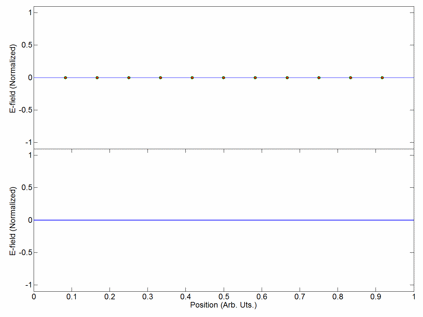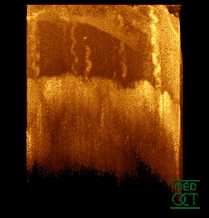|
Kerr-lens Mode Locking
Kerr-lens mode-locking (KLM) is a method of mode-locking lasers via the nonlinear optical Kerr effect. This method allows the generation of pulses of light with a duration as short as a few femtoseconds. The optical Kerr effect is a process which results from the nonlinear response of an optical medium to the electric field of an electromagnetic wave. The refractive index of the medium is dependent on the field strength. Because of the non-uniform power density distribution in a Gaussian beam (as found in laser resonators) the refractive index changes across the beam profile; the refractive index experienced by the beam is greater in the center of the beam than at the edge. Thus a rod of an active Kerr medium functions as a lens for high intensity light. This is called self-focusing and in extreme cases leads to material destruction. In the laser cavity short bursts of light will then be focused differently from continuous waves. To favor the pulsed mode over continuous-wav ... [...More Info...] [...Related Items...] OR: [Wikipedia] [Google] [Baidu] |
Mode-locking
Mode locking is a technique in optics by which a laser can be made to produce pulses of light of extremely short duration, on the order of picoseconds (10−12 s) or femtoseconds (10−15 s). A laser operated in this way is sometimes referred to as a femtosecond laser, for example, in modern refractive surgery. The basis of the technique is to induce a fixed phase relationship between the longitudinal modes of the laser's resonant cavity. Constructive interference between these modes can cause the laser light to be produced as a train of pulses. The laser is then said to be "phase-locked" or "mode-locked". Laser cavity modes Although laser light is perhaps the purest form of light, it is not of a single, pure frequency or wavelength. All lasers produce light over some natural bandwidth or range of frequencies. A laser's bandwidth of operation is determined primarily by the gain medium from which the laser is constructed, and the range of frequencies over which a lase ... [...More Info...] [...Related Items...] OR: [Wikipedia] [Google] [Baidu] |
Pulsed Laser
Pulsed operation of lasers refers to any laser not classified as continuous wave, so that the optical power appears in pulses of some duration at some repetition rate. Silfvast, William T. (1996). ''Laser Fundamentals'', Cambridge University Press. This encompasses a wide range of technologies addressing a number of different motivations. Some lasers are pulsed simply because they cannot be run in continuous mode. In other cases the application requires the production of pulses having as large an energy as possible. Since the pulse energy is equal to the average power divided by the repetition rate, this goal can sometimes be satisfied by lowering the rate of pulses so that more energy can be built up in between pulses. In laser ablation for example, a small volume of material at the surface of a work piece can be evaporated if it is heated in a very short time, whereas supplying the energy gradually would allow for the heat to be absorbed into the bulk of the piece, never attaini ... [...More Info...] [...Related Items...] OR: [Wikipedia] [Google] [Baidu] |
Optical Coherence Tomography
Optical coherence tomography (OCT) is an imaging technique that uses low-coherence light to capture micrometer-resolution, two- and three-dimensional images from within optical scattering media (e.g., biological tissue). It is used for medical imaging and industrial nondestructive testing (NDT). Optical coherence tomography is based on low-coherence interferometry, typically employing near-infrared light. The use of relatively long wavelength light allows it to penetrate into the scattering medium. Confocal microscopy, another optical technique, typically penetrates less deeply into the sample but with higher resolution. Depending on the properties of the light source ( superluminescent diodes, ultrashort pulsed lasers, and supercontinuum lasers have been employed), optical coherence tomography has achieved sub-micrometer resolution (with very wide-spectrum sources emitting over a ~100 nm wavelength range). Optical coherence tomography is one of a class of optical tom ... [...More Info...] [...Related Items...] OR: [Wikipedia] [Google] [Baidu] |
Ultrafast Optics
In optics, an ultrashort pulse, also known as an ultrafast event, is an electromagnetic pulse whose time duration is of the order of a picosecond (10−12 second) or less. Such pulses have a broadband optical spectrum, and can be created by mode-locked oscillators. Amplification of ultrashort pulses almost always requires the technique of chirped pulse amplification, in order to avoid damage to the gain medium of the amplifier. They are characterized by a high peak intensity (or more correctly, irradiance) that usually leads to nonlinear interactions in various materials, including air. These processes are studied in the field of nonlinear optics. In the specialized literature, "ultrashort" refers to the femtosecond (fs) and picosecond (ps) range, although such pulses no longer hold the record for the shortest pulses artificially generated. Indeed, x-ray pulses with durations on the attosecond time scale have been reported. The 1999 Nobel Prize in Chemistry was awarded to A ... [...More Info...] [...Related Items...] OR: [Wikipedia] [Google] [Baidu] |
Self-phase Modulation
Self-phase modulation (SPM) is a nonlinear optical effect of light–matter interaction. An ultrashort pulse of light, when travelling in a medium, will induce a varying refractive index of the medium due to the optical Kerr effect. This variation in refractive index will produce a phase shift in the pulse, leading to a change of the pulse's frequency spectrum. Self-phase modulation is an important effect in optical systems that use short, intense pulses of light, such as lasers and optical fiber communications systems. Self-phase modulation has also been reported for nonlinear sound waves propagating in biological thin films, where the phase modulation results from varying elastic properties of the lipid films. Theory with Kerr nonlinearity The evolution along distance ''z'' of the equivalent lowpass electric field ''A(z)'' obeys the nonlinear Schrödinger equation which, in absence of dispersion, is: :\frac = -j\gamma \left, A(z)\^2 A(z) with ''j'' the imaginary unit and ''� ... [...More Info...] [...Related Items...] OR: [Wikipedia] [Google] [Baidu] |
Chirped Mirror
A chirped mirror is a dielectric mirror with chirped spaces—spaces of varying depth designed to reflect varying wavelengths of lights—between the dielectric layers (stack). Chirped mirrors are used in applications like lasers to reflect a wider range of light wavelengths than ordinary dielectric mirrors, or to compensate for the dispersion of wavelengths that can be created by some optical elements. Chirped mirrors are also found in structurally colored biological systems, including the shiny golden and silver color of certain beetles' elytra, e.g. those of the Ruteline genus ''Chrysina''. In these cases, the chirped mirror generates complex color (such as gold or silver) when illuminated by white light by simultaneously reflecting a broad range of monochromatic colors. Simple explanation An ordinary dielectric mirror is made to reflect a single frequency of light. The dielectric mirror is made of transparent materials that are uniformly layered at a depth of 1/4 the ... [...More Info...] [...Related Items...] OR: [Wikipedia] [Google] [Baidu] |
Bandwidth-limited Pulse
A bandwidth-limited pulse (also known as Fourier-transform-limited pulse, or more commonly, transform-limited pulse) is a pulse of a wave that has the minimum possible duration for a given spectral bandwidth. Bandwidth-limited pulses have a constant phase across all frequencies making up the pulse. Optical pulses of this type can be generated by mode-locked lasers. Any waveform can be disassembled into its spectral components by Fourier analysis or Fourier transformation. The length of a pulse thereby is determined by its complex spectral components, which include not just their relative intensities, but also the relative positions (spectral phase) of these spectral components. For different pulse shapes, the minimum duration-bandwidth product is different. The duration-bandwidth product is minimal for zero phase-modulation. For example, \mathrm pulses have a minimum duration-bandwidth product of 0.315 while gaussian pulses have a minimum value of 0.441. A bandwidth-limited pul ... [...More Info...] [...Related Items...] OR: [Wikipedia] [Google] [Baidu] |
Carrier Envelope Offset Control
In optics, a frequency comb is a laser source whose spectrum consists of a series of discrete, equally spaced frequency lines. Frequency combs can be generated by a number of mechanisms, including periodic modulation (in amplitude and/or phase) of a continuous-wave laser, four-wave mixing in nonlinear media, or stabilization of the pulse train generated by a mode-locked laser. Much work has been devoted to this last mechanism, which was developed around the turn of the 21st century and ultimately led to one half of the Nobel Prize in Physics being shared by John L. Hall and Theodor W. Hänsch in 2005. The frequency domain representation of a perfect frequency comb is a series of delta functions spaced according to : f_n = f_0 + n\,f_r, where n is an integer, f_r is the comb tooth spacing (equal to the mode-locked laser's repetition rate or, alternatively, the modulation frequency), and f_0 is the carrier offset frequency, which is less than f_r. Combs spanning an octave in freq ... [...More Info...] [...Related Items...] OR: [Wikipedia] [Google] [Baidu] |
Group Velocity
The group velocity of a wave is the velocity with which the overall envelope shape of the wave's amplitudes—known as the ''modulation'' or ''envelope'' of the wave—propagates through space. For example, if a stone is thrown into the middle of a very still pond, a circular pattern of waves with a quiescent center appears in the water, also known as a capillary wave. The expanding ring of waves is the wave group, within which one can discern individual waves that travel faster than the group as a whole. The amplitudes of the individual waves grow as they emerge from the trailing edge of the group and diminish as they approach the leading edge of the group. Definition and interpretation Definition The group velocity is defined by the equation: :v_ \ \equiv\ \frac\, where is the wave's angular frequency (usually expressed in radians per second), and is the angular wavenumber (usually expressed in radians per meter). The phase velocity is: . The function , which gi ... [...More Info...] [...Related Items...] OR: [Wikipedia] [Google] [Baidu] |
Telescope
A telescope is a device used to observe distant objects by their emission, absorption, or reflection of electromagnetic radiation. Originally meaning only an optical instrument using lenses, curved mirrors, or a combination of both to observe distant objects, the word ''telescope'' now refers to a wide range of instruments capable of detecting different regions of the electromagnetic spectrum, and in some cases other types of detectors. The first known practical telescopes were refracting telescopes with glass lenses and were invented in the Netherlands at the beginning of the 17th century. They were used for both terrestrial applications and astronomy. The reflecting telescope, which uses mirrors to collect and focus light, was invented within a few decades of the first refracting telescope. In the 20th century, many new types of telescopes were invented, including radio telescopes in the 1930s and infrared telescopes in the 1960s. Etymology The word ''telescope'' was coin ... [...More Info...] [...Related Items...] OR: [Wikipedia] [Google] [Baidu] |
Diffraction
Diffraction is defined as the interference or bending of waves around the corners of an obstacle or through an aperture into the region of geometrical shadow of the obstacle/aperture. The diffracting object or aperture effectively becomes a secondary source of the propagating wave. Italian scientist Francesco Maria Grimaldi coined the word ''diffraction'' and was the first to record accurate observations of the phenomenon in 1660. In classical physics, the diffraction phenomenon is described by the Huygens–Fresnel principle that treats each point in a propagating wavefront as a collection of individual spherical wavelets. The characteristic bending pattern is most pronounced when a wave from a coherent source (such as a laser) encounters a slit/aperture that is comparable in size to its wavelength, as shown in the inserted image. This is due to the addition, or interference, of different points on the wavefront (or, equivalently, each wavelet) that travel by paths of d ... [...More Info...] [...Related Items...] OR: [Wikipedia] [Google] [Baidu] |



.gif)
